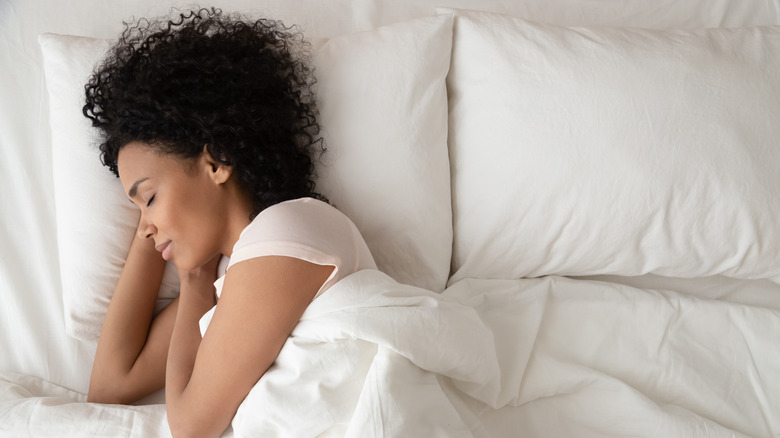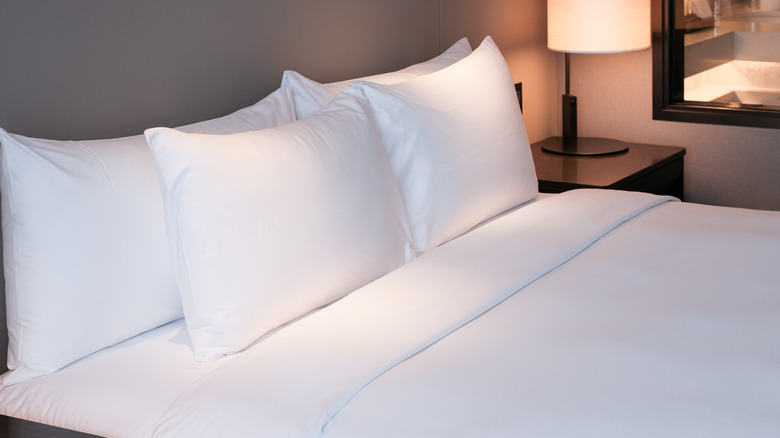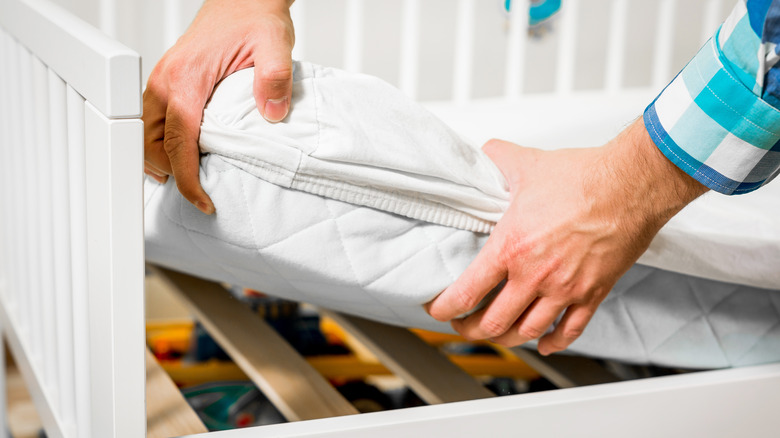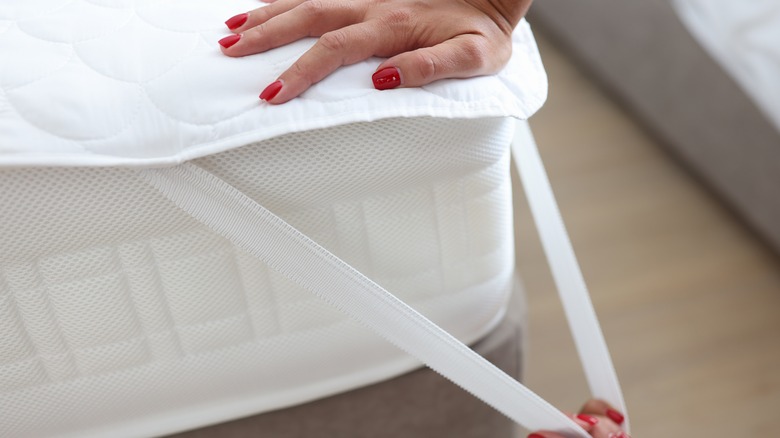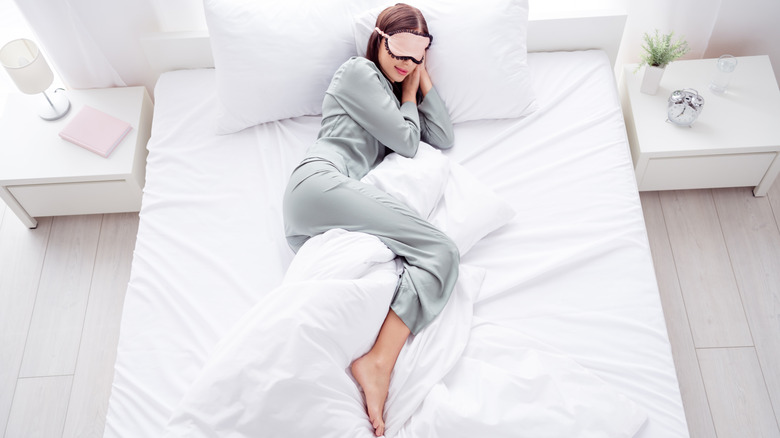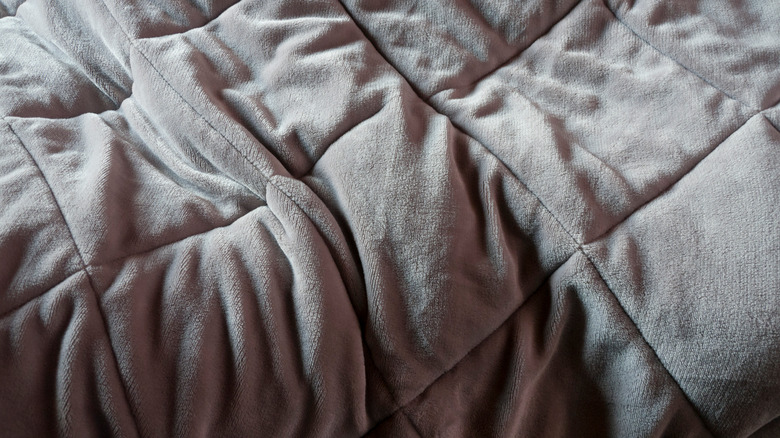5 Easy Ways To Make Your Uncomfortable Bed Cozier
Getting good, deep, consistent sleep is a universal need, and consequently, so is having a comfortable mattress. Sleep Foundation recommends replacing your mattress every six to eight years to ensure you get the best sleep possible. However, sometimes mattresses begin to wear out a little earlier than that, either getting lumpy or dented or otherwise not satisfying your sleep needs.
Having a comfortable bed to sleep in is important for multiple reasons. Not only can a good quality and comfortable mattress help alleviate back pain, but it's also key to better sleeping habits, which can, in turn, boost your metabolism and relieve stress, per The Sleep Doctor. Just because your mattress is a little out of shape, though, doesn't mean you have to buy a new mattress immediately. There are a variety of incredibly easy and effective methods to increase the comfort levels of your current mattress without breaking the bank.
1. Proper pillows
Before putting all the blame on your mattress for your uncomfortable sleep, look at your pillows first. To have the most comfortable night of sleep possible, your spine should be in alignment while you rest. If you have the wrong pillows — too many or too few, too firm or too soft, etc. — you can set your spine out of alignment and wake up sore and stiff, warns Shovlin Mattress.
There's no one-size-fits-all pillow. Instead, you should take into consideration what position you sleep in, which can better address your posture and pillow needs, according to Cornerstone Physiotherapy. For example, back sleepers shouldn't have too much height under their head, but they should add some cushioning to their neck and shoulders to even out their spine. There are even pillows specifically made for back sleepers that address this need. You should also put a pillow under your knees, which can alleviate pressure on your lower back.
Stomach sleeping is a bit more difficult, since your neck will always be out of alignment with your spine. Using a pillow in the first place can make this sleeping position unnecessarily painful. If you want to use one still, use a thin one and only rest your forehead on it, tucking a pillow under your hips for extra support. Side sleepers can use any pillow, but you should add one under your arm to prevent shoulder pain, as well as add cushioning under your neck.
2. Turn or flip mattress
Another easily fixable reason your mattress may be uncomfortable is that you haven't turned or flipped it in a while. Sleeping in the same position night after night can create dents in the foam or springs, making that spot in the mattress less plush than the rest of the bed. You can easily fix this problem by regularly rotating or flipping your mattress.
This said, Amerisleep warns that flipping your mattress can damage it unless it's a special double-sided mattress, so start off with just rotating it. The tag on your mattress will likely tell you how often to do this, but a rough guide is every three to six months. Simply move your mattress until the bottom is at the top, taking care not to knock over any furniture. You can also use this as an opportunity to vacuum or clean out the bed frame.
If you can flip your mattress, check with the tag or manufacturer for an exact timeline, but a good rule of thumb is every six months. You can rotate it first, or simply flip it. This is easiest with a friend, but you can still do it by yourself — just lift it and rest it against a nearby wall, and then slowly lower it down on the opposite end.
3. Mattress pad or topper
If your mattress is a little worn down, but not necessarily in need of replacement, you can amend the firmness and comfort with a mattress pad or topper. The two products are technically different, but they work to achieve the same goal.
Per Amerisleep, mattress toppers are the heavier-duty option between the two. It's essentially a smaller, thinner, additional mattress, meant to actually change the way your mattress feels. If you feel your mattress is too firm, you can get a mattress topper that makes it softer, and vice versa. Mattress pads, meanwhile, are more of a protective layer to add on top of your mattress, providing both extra plushness and protection from dirt and debris.
Mattress pads are removable and thinner than mattress toppers and are first and foremost meant to keep your mattress clean, then add some plushness. Using a topper and pad in combination can immensely increase how comfortable your mattress is.
4. Body pillow
Even if you switch to the right pillow for your sleeping position, you still may need a little more support, which can make your bed feel uncomfortable. In this case, consider getting a body pillow. Body pillows are just what they sound like — a long pillow the size of your body, meant to provide additional support and cushioning through the night.
According to Casper, body pillows are best for side sleepers — necessary, even — but can have beneficial properties to any sleeper. Body pillows are meant to align with your body and be grabbed or hugged, allowing your head, neck, and shoulders to align comfortably while you sleep. You can even tuck the pillow between your knees or under your hips for added support. Body pillows also help open up your air passage while you sleep and prevent snoring, as well as increase digestive health by preventing stomach acid from rising to your throat.
5. Weighted blankets
Finally, your uncomfortable bed may have nothing to do with your mattress at all, but your own ability — or inability — to find sleep. If this is the case, there are plenty of solutions to help stimulate comfortable and relaxed sleep, like aromatherapy, mood lighting, or even weighted blankets.
Weighted blankets are just what they sound like: a blanket offering additional weight, from either a dense yarn weave or a weighted filling, according to the Sleep Foundation. Weighted blankets are linked to increased serotonin levels and decreased cortisol levels, similar in effect to a baby swaddle. They're especially effective for people with sensory issues, anxiety, or who have increased levels of stress or restlessness.
Weighted blankets can be found as light as 7 pounds to as heavy as 25 pounds, depending on your preferences. A study published in the Journal of Clinical Sleep Medicine found that people with insomnia had lessened symptoms after using a weighted blanket, and that it also lessened symptoms of depression and anxiety.
